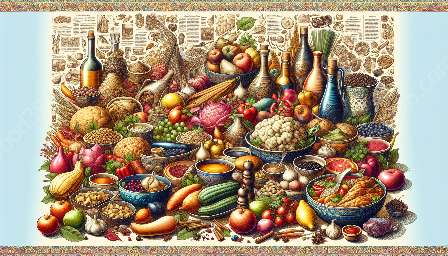The link between food and the environment is deeply rooted in ancient cultures, where geographical and climatic conditions significantly influenced traditional food practices, rituals, and the evolution of food culture.
Ancient Food Traditions and Their Reflection of Geographical Conditions:
Ancient food traditions in different regions were intricately connected to the available resources, geographic features, and climate. From the fertile lands of the Nile Valley to the rugged terrains of the Andes, each region's unique conditions influenced the types of foods cultivated, harvested, and consumed.
Nile Valley: The ancient Egyptians relied on the annual flooding of the Nile River, which deposited nutrient-rich silt to support agricultural production. This led to the cultivation of crops such as wheat, barley, and flax, which formed the basis of their diet. The abundance of fish in the Nile also contributed to their food traditions.
Andes: In the Andean region, the terrain and altitude greatly influenced the types of crops that could be grown. The cultivation of potatoes, quinoa, and maize became integral to the region's food traditions. The Incas, known for their advanced agricultural practices, adapted to the challenging conditions and developed innovative methods to cultivate food at different altitudes.
Asian Rice Cultures: In regions with abundant rainfall and suitable temperatures, such as Southeast Asia, the cultivation of rice flourished. Rigorous irrigation systems and terraced fields were developed to support rice farming, and rice became a staple food, shaping the dietary and cultural traditions of these regions.
Climatic Influence on Ancient Food Traditions:
Climate played a crucial role in shaping food preservation techniques, culinary practices, and dietary preferences. The availability of sunlight, temperature variations, and seasonal changes impacted the ways in which ancient societies prepared, stored, and consumed food.
Food Preservation: In colder climates, methods such as drying, smoking, and fermentation were employed to preserve food for longer periods, allowing ancient communities to sustain themselves through harsh winters. In warmer regions, the emphasis was on techniques such as pickling and sun-drying to preserve perishable foods.
Culinary Practices: The climatic conditions also influenced cooking methods and flavor combinations. Spices and herbs were used not only for their flavors but also for their natural preservative properties. Coastal regions often incorporated seafood into their diets, while landlocked areas focused on animal husbandry and crop cultivation.
Origin and Evolution of Food Culture:
Ancient food traditions were intricately connected to rituals, social structures, and religious beliefs. These traditions often formed the foundation of early civilizations and evolved over time, shaping the cultural identities and culinary legacies of diverse societies.
Rituals and Festivals: Ancient food traditions were closely tied to rituals and ceremonies, reflecting the community's relationship with nature, agricultural cycles, and spiritual beliefs. Harvest festivals, feasts, and communal meals played a significant role in fostering social cohesion and reinforcing cultural values.
Trade and Exchange: As ancient civilizations interacted through trade routes, the exchange of foodstuffs, culinary techniques, and cultural practices facilitated the spread and evolution of food culture. Ingredients such as spices, grains, and livestock were traded, leading to the integration of diverse flavors and culinary traditions.
Social Significance: The preparation and sharing of food held deep social and symbolic meanings in ancient societies. Meals were often a reflection of hierarchy, hospitality, and familial bonds. Special foods were reserved for specific occasions, symbolizing abundance, fertility, and communal prosperity.
Conclusion:
Ancient food traditions provide valuable insights into how geographical and climatic conditions shaped the origins and evolution of food culture. Understanding the interplay between environmental factors, cultural practices, and social dynamics offers a holistic view of ancient civilizations and their relationship with food. By exploring these traditions, we gain a deeper appreciation for the diversity and resilience of ancient food cultures across different regions.


